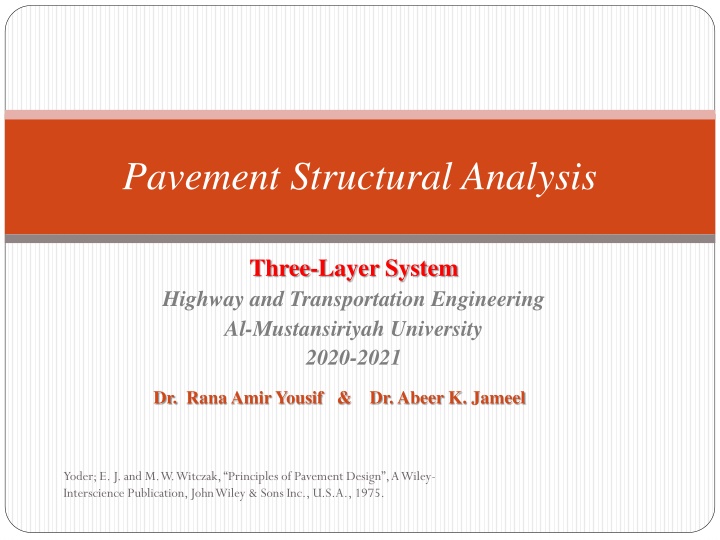
Structural Analysis of Three-Layer Pavement System
Explore the structural analysis of a three-layer pavement system in highway and transportation engineering. This study delves into stress and strain calculations at interfaces, considering material properties and layer dimensions. Detailed solutions and diagrams provide insights into pavement design principles, offering a comprehensive understanding of the topic.
Download Presentation

Please find below an Image/Link to download the presentation.
The content on the website is provided AS IS for your information and personal use only. It may not be sold, licensed, or shared on other websites without obtaining consent from the author. If you encounter any issues during the download, it is possible that the publisher has removed the file from their server.
You are allowed to download the files provided on this website for personal or commercial use, subject to the condition that they are used lawfully. All files are the property of their respective owners.
The content on the website is provided AS IS for your information and personal use only. It may not be sold, licensed, or shared on other websites without obtaining consent from the author.
E N D
Presentation Transcript
Pavement Structural Analysis Three-Layer System Highway and Transportation Engineering Al-Mustansiriyah University 2020-2021 Dr. Rana Amir Yousif & Dr. Abeer K. Jameel Yoder; E. J. and M. W. Witczak, Principles of Pavement Design , A Wiley- Interscience Publication, John Wiley & Sons Inc., U.S.A., 1975.
References Nicholas J. Garber and Lester A. Hoel. Traffic and Highway Engineering , Fourth Edition. Yoder; E. J. and M. W. Witczak, Principles of Pavement Design , A Wiley- Interscience Publication, John Wiley & Sons Inc., U.S.A., 1975. Yaug H. Huang, Pavement Analysis and Design , Prentic Hall Inc., U.S.A., 1993. AASHTO Guide for Design of Pavement Structures 1993 , AASHTO, American Association of State Highway and Transportation Officials, U.S.A., 1993. Oglesby Clarkson H., HighwayEngineering , John Wiley & Sons Inc., U.S.A., 1975. Yoder; E. J. and M. W. Witczak, Principles of Pavement Design , A Wiley- Interscience Publication, John Wiley & Sons Inc., U.S.A., 1975.
Three-Layer Systems Example (2,11) Page 71: Figure 2 .30 with a = 4 .8 in. (122 mm), q = 120 psi (828 kPa), h1 = 6 in. (152 mm), h2 = 6 in. (203 mm), E1 = 400,000 psi (2.8 GPa), E2 = 20,000 psi (138 MPa), and E3 = 10,000 psi (69 MPa), determine all the stresses and strains at the two interfaces on the axis of symmetry . Given the three-layer system shown in Yoder; E. J. and M. W. Witczak, Principles of Pavement Design , A Wiley- Interscience Publication, John Wiley & Sons Inc., U.S.A., 1975.
Three-Layer Systems Solution: Given k1= 400,000/20,000 = 20 A=4.8/6 = 0.8 k2= 20,000/10,000 = 2 H= 6/6 = 1.0 Yoder; E. J. and M. W. Witczak, Principles of Pavement Design , A Wiley- Interscience Publication, John Wiley & Sons Inc., U.S.A., 1975.
Three-Layer Systems k1=20 From Table (2.3) ZZ1= 0.12173 ZZ2= 0.05938 ZZ1-RR1=1.97428 ZZ2-RR2= 0.09268 k2=2 A=0.8 H=1.0 Yoder; E. J. and M. W. Witczak, Principles of Pavement Design , A Wiley- Interscience Publication, John Wiley & Sons Inc., U.S.A., 1975.
Three-Layer Systems From Eq. 2 .24 = 120* 0.12173 = 14.61 psi = 120 * 0.05938 = 7.12 psi = 120 * 1.97428 = 236.91 psi = 120 * 0.09268 = 11.12 psi Yoder; E. J. and M. W. Witczak, Principles of Pavement Design , A Wiley- Interscience Publication, John Wiley & Sons Inc., U.S.A., 1975.
Three-Layer Systems From Eq. 2 .23 = 236.91/20 = 11.85 psi = 11.12/2 = 5.56 psi Yoder; E. J. and M. W. Witczak, Principles of Pavement Design , A Wiley- Interscience Publication, John Wiley & Sons Inc., U.S.A., 1975.
Three-Layer Systems At bottom of layer 1 = 14.61 236.91 = - 222.3 psi. From Eq. 2 .20 = 236 .91/400,000 = 5 .92 x 10^-4 = -2 .96 X 10^ -4 Yoder; E. J. and M. W. Witczak, Principles of Pavement Design , A Wiley- Interscience Publication, John Wiley & Sons Inc., U.S.A., 1975.
Three-Layer Systems At top of layer 2 = 14.61 11 .85 = 2.76 psi. From Eq. 2 .20 = 11.85/20,000 = 5.92 x 10^-4 = -2.96 X 10^-4 Yoder; E. J. and M. W. Witczak, Principles of Pavement Design , A Wiley- Interscience Publication, John Wiley & Sons Inc., U.S.A., 1975.
Three-Layer Systems At bottom of layer 2 = 7.12 - 11 .12 = -4.0 psi. From Eq. 2 .20 = 11 .12/20,000 = 5 .56 * 10^-4 = -2 .78 * 10^-4 Yoder; E. J. and M. W. Witczak, Principles of Pavement Design , A Wiley- Interscience Publication, John Wiley & Sons Inc., U.S.A., 1975.
Three-Layer Systems At top of layer 3 = 7.12 - 5 .56 = 1 .56 psi. From Eq. 2 .20 = 5.56/10,000 = 5 .56 * 10^-4 = -2 .78 * 10^-4 Yoder; E. J. and M. W. Witczak, Principles of Pavement Design , A Wiley- Interscience Publication, John Wiley & Sons Inc., U.S.A., 1975.
Three-Layer Systems Dr. Rana Amir Yousif & Dr. Abeer K. Jameel Yoder; E. J. and M. W. Witczak, Principles of Pavement Design , A Wiley- Interscience Publication, John Wiley & Sons Inc., U.S.A., 1975.



















